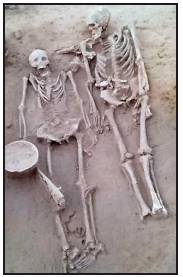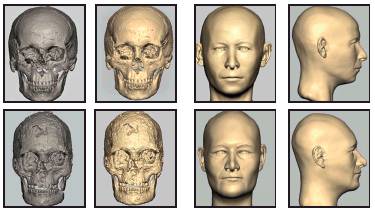Rakhigarhi
| Line 7: | Line 7: | ||
|} | |} | ||
| − | + | ||
| − | + | ||
| − | + | ||
=Excavations= | =Excavations= | ||
| Line 40: | Line 40: | ||
“It is more plausible that two individuals died at the same time or almost the same time, and were buried together in the same grave,” Shinde said. | “It is more plausible that two individuals died at the same time or almost the same time, and were buried together in the same grave,” Shinde said. | ||
| + | |||
| + | =Looks: what did the people look like?= | ||
| + | ==Very Caucasoid== | ||
| + | [https://epaper.timesgroup.com/Olive/ODN/TimesOfIndia/shared/ShowArticle.aspx?doc=TOIDEL/2019/10/10&entity=Ar01700&sk=A8725A91&mode=text Aarti Singh , Oct 10, 2019: ''The Times of India''] | ||
| + | |||
| + | [[File: Original skulls (left) of two individuals which went through cranofacial reconstruction and the final facial appearance after reconstruction.jpg|Original skulls (left) of two individuals which went through cranofacial reconstruction and the final facial appearance after reconstruction <br/> From: [https://epaper.timesgroup.com/Olive/ODN/TimesOfIndia/shared/ShowArticle.aspx?doc=TOIDEL/2019/10/10&entity=Ar01700&sk=A8725A91&mode=text Aarti Singh , Oct 10, 2019: ''The Times of India'']|frame|500px]] | ||
| + | |||
| + | In a first, scientists have generated an accurate facial representation of the Indus Valley Civilisation people by reconstructing the faces of two of the 37 individuals who were found buried at the 4,500-year-old Rakhigarhi cemetry. | ||
| + | |||
| + | A multi-disciplinary team of 15 scientists and academics from six different institutes of South Korea, UK and India, applied craniofacial reconstruction (CFR) technique using computed tomography (CT) data of two of the Rakhigarhi skulls, to recreate their faces. The case study, led by W J Lee and Vasant Shinde and supported in part by a grant of the National Geographic Society, has been published in a widely reputed journal, Anatomical Science International. | ||
| + | |||
| + | “The report is very significant because till date, we have had no idea about how Indus Valley people looked. But now we have got some idea about their facial features,” Shinde, who led the Rakhigarhi archaeological project, told TOI. Located in Haryana, Rakhigarhi is one of the largest Indus Valley sites. | ||
| + | |||
| + | It was difficult to establish the physical appearance so far because “Indus Valley cemeteries and graves have not been investigated sufficiently to date” and “the anthropological data obtained from the skeletons still fall short” for recreating morphology of the Indus Valley people. Also, except for “the Priest King, a famous figurine found at Mohenjodaro,” there is no advanced or developed art from the Indus Valley civilisation that could lead to an accurate representation of the morphology of its population. | ||
| + | |||
| + | “The CFR technology generated faces of the two Rakhigarhi skulls, therefore, is a major breakthrough,” Shinde, a professor at Deccan College Post-Graduate and Research Institute, said. Going by the 3-D video representation of the faces, the two individuals of the Rakhigarhi settlement appeared to have Caucasian features with hawk-shaped and Roman noses. | ||
| + | The study, however, cautioned against drawing any generic conclusions. | ||
| + | |||
=See also= | =See also= | ||
| Line 45: | Line 63: | ||
[[Rakhigarhi]] | [[Rakhigarhi]] | ||
| + | |||
| + | [[Category:History|R | ||
| + | RAKHIGARHI]] | ||
| + | [[Category:India|R | ||
| + | RAKHIGARHI]] | ||
| + | [[Category:Places|R | ||
| + | RAKHIGARHI]] | ||
Revision as of 20:49, 7 June 2021
This is a collection of articles archived for the excellence of their content. |
Contents |
Excavations
2019: In a first, couple found in Harappan grave
Neha Madaan, In a first, ancient couple found in Harappan grave, January 9, 2019: The Times of India

From: Neha Madaan, In a first, ancient couple found in Harappan grave, January 9, 2019: The Times of India
A rare couple’s grave — the skeletal remains of a young man and woman, interred with his face turned towards her — has been excavated at the Harappan settlement at Rakhigarhi in Haryana, about 150km from Delhi. This is the first couple’s grave that archaeologists have confirmed in a Harappan cemetery. Although many Harappan settlements and cemeteries have been investigated, no couple burials have been reported till date.
Archaeologists from Deccan College Deemed University, Pune, who are excavating the site, said the skeletons were found lying face up with arms and legs extended. They said evidence indicated the couple was buried simultaneously or about the same time. The findings were recently published in the peer-reviewed international journal, ACB Journal of Anatomy and Cell Biology.
The excavation and analysis were undertaken by the university’s department of archaeology and Institute of Forensic Science, Seoul National University College of Medicine. Vasant Shinde, one of the authors of the paper, told TOI that Indian archaeologists had often debated the meaning of joint burials. A Harappan joint burial site discovered at Lothal in the past was considered an instance of a widow’s sacrifice following her husband’s death, he said.
HARAPPAN EXCAVATION
‘Both individuals could have died at same time’
Other archaeologists said it was difficult to estimate the sexes of the individuals, and that they may not have been a couple. Other than the contentious Lothal case, none of the joint burials reported from Harappan cemeteries till date have been anthropologically confirmed to be a couple’s grave,” he said.
The manner in which the individuals were buried in the Rakhigarhi site could indicate lasting affection after death. “We can only infer, but those who buried the two individuals may have wanted to imply that the love between the two would continue even
after death,” he said. “A couple’s joint grave is not so rare in other ancient civilisations. Yet, it is strange they were not discovered in Harappan cemeteries till now,” he said.
The grave had burial pottery and a banded agate bead, probably part of a necklace.
Both skeletons were brought to the laboratory of Deccan College for analysis after field surveys were completed. Each skeleton’s sex was determined after studying the pelvic region. Their ages at the time of death has been estimated at between 21 and 35 years and the man’s height as 5 feet 6 inches and the woman’s as 5 feet 2 inches.
“It is more plausible that two individuals died at the same time or almost the same time, and were buried together in the same grave,” Shinde said.
Looks: what did the people look like?
Very Caucasoid
Aarti Singh , Oct 10, 2019: The Times of India

From: Aarti Singh , Oct 10, 2019: The Times of India
In a first, scientists have generated an accurate facial representation of the Indus Valley Civilisation people by reconstructing the faces of two of the 37 individuals who were found buried at the 4,500-year-old Rakhigarhi cemetry.
A multi-disciplinary team of 15 scientists and academics from six different institutes of South Korea, UK and India, applied craniofacial reconstruction (CFR) technique using computed tomography (CT) data of two of the Rakhigarhi skulls, to recreate their faces. The case study, led by W J Lee and Vasant Shinde and supported in part by a grant of the National Geographic Society, has been published in a widely reputed journal, Anatomical Science International.
“The report is very significant because till date, we have had no idea about how Indus Valley people looked. But now we have got some idea about their facial features,” Shinde, who led the Rakhigarhi archaeological project, told TOI. Located in Haryana, Rakhigarhi is one of the largest Indus Valley sites.
It was difficult to establish the physical appearance so far because “Indus Valley cemeteries and graves have not been investigated sufficiently to date” and “the anthropological data obtained from the skeletons still fall short” for recreating morphology of the Indus Valley people. Also, except for “the Priest King, a famous figurine found at Mohenjodaro,” there is no advanced or developed art from the Indus Valley civilisation that could lead to an accurate representation of the morphology of its population.
“The CFR technology generated faces of the two Rakhigarhi skulls, therefore, is a major breakthrough,” Shinde, a professor at Deccan College Post-Graduate and Research Institute, said. Going by the 3-D video representation of the faces, the two individuals of the Rakhigarhi settlement appeared to have Caucasian features with hawk-shaped and Roman noses. The study, however, cautioned against drawing any generic conclusions.
See also
Rakhigarhi